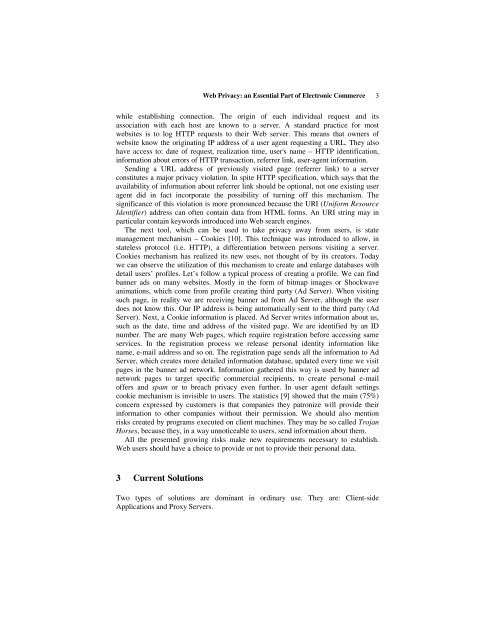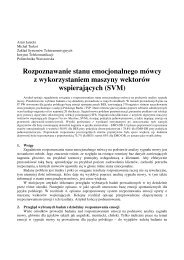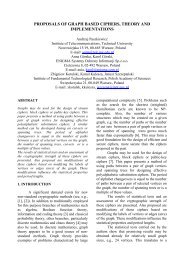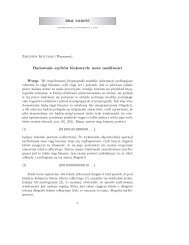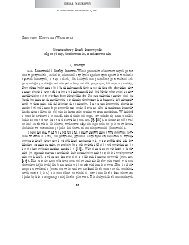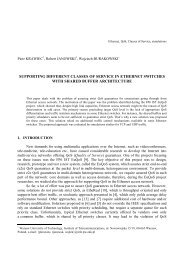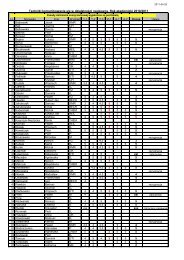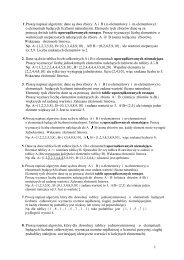Web Privacy - Krzysztof Szczypiorski
Web Privacy - Krzysztof Szczypiorski
Web Privacy - Krzysztof Szczypiorski
You also want an ePaper? Increase the reach of your titles
YUMPU automatically turns print PDFs into web optimized ePapers that Google loves.
<strong>Web</strong> <strong>Privacy</strong>: an Essential Part of Electronic Commerce 3while establishing connection. The origin of each individual request and itsassociation with each host are known to a server. A standard practice for mostwebsites is to log HTTP requests to their <strong>Web</strong> server. This means that owners ofwebsite know the originating IP address of a user agent requesting a URL. They alsohave access to: date of request, realization time, user's name – HTTP identification,information about errors of HTTP transaction, referrer link, user-agent information.Sending a URL address of previously visited page (referrer link) to a serverconstitutes a major privacy violation. In spite HTTP specification, which says that theavailability of information about referrer link should be optional, not one existing useragent did in fact incorporate the possibility of turning off this mechanism. Thesignificance of this violation is more pronounced because the URI (Uniform ResourceIdentifier) address can often contain data from HTML forms. An URI string may inparticular contain keywords introduced into <strong>Web</strong> search engines.The next tool, which can be used to take privacy away from users, is statemanagement mechanism – Cookies [10]. This technique was introduced to allow, instateless protocol (i.e. HTTP), a differentiation between persons visiting a server.Cookies mechanism has realized its new uses, not thought of by its creators. Todaywe can observe the utilization of this mechanism to create and enlarge databases withdetail users’ profiles. Let’s follow a typical process of creating a profile. We can findbanner ads on many websites. Mostly in the form of bitmap images or Shockwaveanimations, which come from profile creating third party (Ad Server). When visitingsuch page, in reality we are receiving banner ad from Ad Server, although the userdoes not know this. Our IP address is being automatically sent to the third party (AdServer). Next, a Cookie information is placed. Ad Server writes information about us,such as the date, time and address of the visited page. We are identified by an IDnumber. The are many <strong>Web</strong> pages, which require registration before accessing sameservices. In the registration process we release personal identity information likename, e-mail address and so on. The registration page sends all the information to AdServer, which creates more detailed information database, updated every time we visitpages in the banner ad network. Information gathered this way is used by banner adnetwork pages to target specific commercial recipients, to create personal e-mailoffers and spam or to breach privacy even further. In user agent default settingscookie mechanism is invisible to users. The statistics [9] showed that the main (75%)concern expressed by customers is that companies they patronize will provide theirinformation to other companies without their permission. We should also mentionrisks created by programs executed on client machines. They may be so called TrojanHorses, because they, in a way unnoticeable to users, send information about them.All the presented growing risks make new requirements necessary to establish.<strong>Web</strong> users should have a choice to provide or not to provide their personal data.3 Current SolutionsTwo types of solutions are dominant in ordinary use. They are: Client-sideApplications and Proxy Servers.


